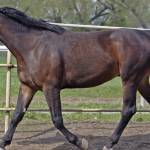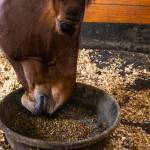How Lame Is Lame?

“My horse looks a little bit off” is quite different from “My horse is three-legged lame,” but both describe equines that show some degree of unsoundness. To simplify the descriptions of lameness, the American Association of Equine Practitioners developed this numeric scale that covers any degree of unsoundness from mild to severe.
Grade 0 means the horse shows no perceptible lameness under any conditions.
Grade 1 describes a horse in which lameness is difficult to see and is not consistent. The horse may look slightly lame at some times and not at others, regardless of whether it is worked in hand or under saddle, on hard or soft ground, and in straight or circular patterns.
Grade 2 means the lameness is hard to detect at a walk or trot in a straight line. However, it can consistently be seen under certain conditions such as when the horse is ridden, moves in a circle, goes up or down an incline, or works on a hard surface.
Grade 3 refers to a horse in which lameness is easy to see when the horse is trotting, regardless of surface, speed, direction, or incline.
Grade 4 means lameness is easy to see when the horse is walking.
Grade 5 describes a horse that is reluctant to bear weight on the affected limb, either standing still or moving, or is completely unwilling or unable to move.
While some cases of lameness are fairly easy to diagnose and treat, others are difficult because the signs are subtle or intermittent. Lameness may result from an injury to a leg or hoof, but it can also be seen as a result of neurologic conditions, back pain, muscle imbalances, or a shoeing problem. Owners should consult a veterinarian if they notice signs of lameness. While some mild lameness may disappear with rest, other cases will resolve much more quickly with veterinary treatment.








